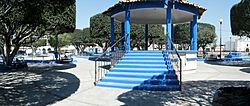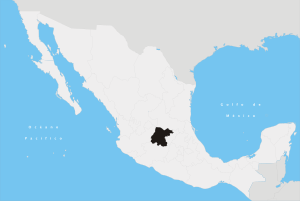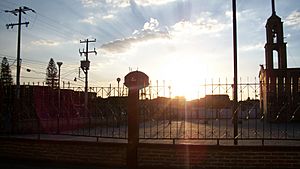Valtierrilla facts for kids
Quick facts for kids
Valtierrilla
|
|
|---|---|
| Valtierrilla | |

Kiosk Valtierrilla
|
|
 |
|
| Founded by | 1593 (Don Gaspar de Valdes) |
| Ranked 32nd | |
| Elevation | 1,710 m (5,610 ft) |
| Population | |
| • Total | 12,713 |
| Time zone | CST, (UTC-6) |
| • Summer (DST) | UTC-6 (CDT) |
| Postal code |
36881
|
Valtierrilla is a village in the Mexican state of Guanajuato. It is located near the city of Salamanca. In 2007, about 13,200 people lived there.
Valtierrilla is famous for its nopal cactus. It is even called the "world capital" of this fruit-bearing cactus. The village is also growing as an industrial area. It is the largest community in the Salamanca area, besides Salamanca city itself.
Contents
- What Does Valtierrilla Mean?
- Where is Valtierrilla Located?
- Who are Valtierrilla's Famous People?
- How Many People Live in Valtierrilla?
- What is Valtierrilla's History?
- What Schools are in Valtierrilla?
- What is Exponopal?
- What Sports are Popular in Valtierrilla?
- What are Valtierrilla's Landmarks?
- See also
What Does Valtierrilla Mean?
After the Spanish conquest, the village was first called Valtierra. This name comes from Latin words meaning "place of much land." In the 1600s, a larger estate called Valtierra la Grande was created. To tell them apart, people started calling this village Valtierra la Chica (Small Valtierra).
In the early 1700s, the people added "Santa Cruz" to the name. This showed the area's new Christian faith. So, it became Santa Cruz Baltierrilla.
In 1918, the name changed to Andres Delgado. However, people linked this name to a famous bandit. This caused confusion for travelers and locals. The local priest, Father Jesús Méndez Montoya, helped change the name back. On February 9, 1928, the name Valtierrilla was officially restored.
Where is Valtierrilla Located?
Valtierrilla is about 8 kilometers (5 miles) from Salamanca. It sits in a flat area called El Bajío. This area is close to where the Lerma and Laja rivers meet. The village covers about 150 square kilometers (58 square miles).
Valtierrilla is 1,710 meters (5,610 feet) above sea level. There is a rocky hill nearby called Cerro de Comaleros. It is about 1.5 kilometers (1 mile) from the village. The Laja River flows south of the town. It joins the Lerma River about 4 kilometers (2.5 miles) away.
The weather in Valtierrilla is warm and semi-dry. Most of the rain falls in the summer and early fall.
Who are Valtierrilla's Famous People?
Valtierrilla has been home to several important people:
- Prof. Aurelio Méndez Sánchez: A teacher and leader. He helped the community grow in the mid-1900s.
- St. Barnabas Jesus Mendez Montoya: A priest who died during the Cristero War in Mexico. He was shot on February 5, 1928. Pope John Paul II made him a saint in 2000.
- Father Alberto Campos: Another priest who helped develop the community in the mid-1900s.
- Sebastian de la Cruz: Valtierrilla's first mayor in 1733. He helped build the Chapel of the Holy Cross. He also worked to get land back for the people.
How Many People Live in Valtierrilla?
In 1754, Valtierrilla had 406 people. Salamanca had 1,508. By 1900, Valtierrilla's population grew to 2,016. Salamanca had 13,583 people then.
According to the 2005 census, Valtierrilla had 12,118 residents. This was about 5.19% of Salamanca's total population. In 2007, the population increased to 13,200.
What is Valtierrilla's History?
Ancient Times
The first people lived in Valtierrilla around 400 to 200 BCE. They were part of the Chupicuaro culture. These groups were semi-nomadic, meaning they moved around. They settled near the Lerma and Laja rivers. They lived in small villages with equal social structures.
In 1985, workers building a bridge found ancient remains. They discovered a stone pyramid or stepped structure. It was about 20 meters (65 feet) wide and less than 10 meters (33 feet) tall. This structure was built using dry stones, without mortar. Sadly, the stones were removed instead of being saved. The Chupicuaro people later left the area.
The Aztecs might have passed through this region. This was during their journey to the Valley of Mexico around the 12th or 13th century. However, they did not settle here. Before the Spanish arrived, groups like the Chichimecas, Pames, and Guamares lived along the rivers.
Colonial Period
After the Spanish conquest, explorers came to the Chichimec region. In 1593, Don Gaspar de Váldez registered ranches in the area. These included Mancera and Valtierra. In 1602, a Spanish group asked to settle near the river. This led to the founding of Salamanca on August 6, 1602.
In the 1700s, the people of Santa Cruz Valtierrilla asked for their land back. They had lost land to Santa Maria Nativitas. In 1716, the Royal Audience in Mexico City helped them. The land was returned, and rent was paid.
In 1724, the first chapel was built in Valtierrilla. It was called "Santa Cruz" and was for celebrating Mass. The Viceroy approved its construction.
The people of Valtierrilla wanted to choose their own leaders. In 1732, they asked the Viceroy for this right. In 1733, the Viceroy agreed. So, in 1734, Valtierrilla held its first election. Sebastián de la Cruz became the first mayor. Land disputes continued, but the people often won their rights back.
By 1807, the local leaders complained about high taxes. This made the people support the independence movement. Many communities, including "Baltierrilla," also donated money to Spain's war with France.
Fight for Independence
The people of Valtierrilla supported the fight for independence. This movement was started by Miguel Hidalgo. A local leader named Andres Delgado El giro led over 200 men. They attacked in the region and set up a base in Valtierrilla. In 1818, Andres Delgado was captured and shot.
In 1838, a terrible typhus epidemic hit Valtierrilla. So many people died that they were buried in the chapel courtyard.
In 1858, a major battle of the Reform War happened in Valtierrilla. This war was between Liberal and Conservative armies. The fighting was very fierce, especially near a bridge. It was one of the first big battles of the war.
In 1871, the telegraph system was installed. This connected Salamanca to Valtierrilla and other towns.
Recent Times
In the early 1900s, the state promoted education. "Model schools" opened in Valtierrilla in 1903. There were separate schools for boys and girls.
In 1918, the village name changed to Andres Delgado. This honored the local guerrilla fighter. But in 1928, it was changed back to Valtierrilla.
In 1918, a cholera epidemic also reached Valtierrilla. It caused many deaths.
In 1922, Valtierrilla tried to separate from Salamanca. The mayor of Salamanca said no. He argued that the village was "ignorant" and could not govern itself. The request failed.
In 1926, the Cristero movement grew strong. On February 19, 1928, federal forces entered Valtierrilla. They shot Jesús Méndez Montoya, who later became a saint.
In 1952, the government granted land to 47 farmers in Valtierrilla. This land was called an ejido. In 1977, some of this land was taken to expand a refinery.
What Schools are in Valtierrilla?
Valtierrilla has several schools for different age groups:
- Preschools: Tomasa Esteves, Jaime Torres Bodet, Octavio Gómez Leal, and a new one.
- Primary Schools: Mariano Matamoros, Guadalupe Victoria, 20 November, Joan of Asbaje, Agustín Melgar.
- High Schools: Secondary School No. 23 Tele and High School "Aurelio Sanchez Mendez."
- Senior High School: Bachelor's and Video Training Center UNICATT State Government.
What is Exponopal?
Since 2005, Valtierrilla has hosted "Exponopal" every February. This exhibition celebrates the nopal cactus. It brings together people who grow and sell nopal products. They come from all over Mexico.
Exhibitors show off many different nopal items. These include nopal stew, cactus tortillas, and even nopal shampoo. You can also find nopal jelly, jam, skin creams, and juices. There are also candies and cactus fruit covered in almonds and chocolate.
What Sports are Popular in Valtierrilla?
Football (soccer) has been played in Valtierrilla for about 70 years.
Weightlifting is also a popular sport. Valtierrilla has produced state-level champions. Edith Montserrat Silva Vazquez has won Pan-American championships. She also has three gold medals from national competitions. Jorge "Conejo" Godoy is another gold medalist from the national Olympics.
What are Valtierrilla's Landmarks?
- The Main Square of the Revolution: A central gathering place.
- Chapel of Santa Cruz: Built by the townspeople in 1724 for Mass.
- Church of the Sacred Heart of Jesus: Another important church.
- Church of Our Lady of Guadalupe: A beautiful church in the village.
- Pyramid of stone or ceremonial center: Located on Comaleros hill, an ancient structure.
See also
 In Spanish: Valtierrilla para niños
In Spanish: Valtierrilla para niños


